White Pine Blister Rust
French common name: Rouille vésiculeuse du pin blanc
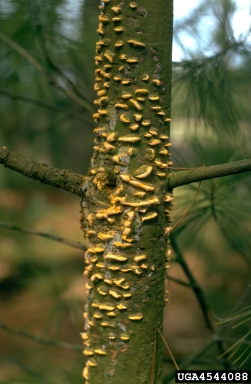
Photo: Petr Kapitola, Central Institute for Supervising and Testing in Agriculture, Bugwood.org.
Order: Pucciniales
Family: Cronartiaceae
Did you know? White pine
blister rust is a type of rust fungus that requires 2 hosts to survive. While they rely primarily on white pine trees, they also depend on alternative plant hosts such as currants and gooseberries.
Introduction
White pine blister rust (WPBR) is a disease caused by an invasive rust fungus that threatens white pine in Canada. Cronartium ribicola, the rust pathogen, is native to Asia but was introduced to Canada in the early 1900s. Since its introduction, WPBR has devasted eastern white pines in the East and endangered whitebark and limber pine species in the West. While it is difficult to control in large natural stands, WPBR is more easily managed in urban environments where site factors can reduce the survival and success of spores. There are 2 main types of spores produced in the lifecycle of WPBR: aecial spores produced on white pine hosts and basidiospores produced on Ribes (currant and gooseberry) hosts. By alternating hosts, the fungus can survive longer and continue the cycle of infecting new white pine trees. Learning how to prevent and manage the spread of white pine blister rust is important to reduce the risk of additional ecological, economic, and social harm.
General Information
The early signs and symptoms of white pine blister rust are typically harder to find but become quite apparent as the disease progresses.
Needles: The disease initially appears as yellow/orange spots on white pine needles. The needles eventually turn brown as the infection spreads and will remain attached to the stem when they die.
Stem/Trunk: Orange/brown cankers form when the infection reaches the stem. Over time, these swelling cankers turn brown and secrete heavy resin that attracts animals such as rodents. White blisters that eventually turn yellow will appear at the canker site during spore production and release. The canker eventually girdles the branch, causing it to break off in the wind or under heavy snow.
Canopy: White pine blister rust can also be seen from afar by looking at the canopy. Common symptoms of WPBR include flagging branches, broken branches, and dying treetops (topkill). In all 3 cases, the needles will appear brown or orange in colour instead of green.
Ribes leaves: The disease appears as orange or yellow spores on the underside of Ribes leaves. These spores grow into tiny hair-like projections in the late summer and early fall.
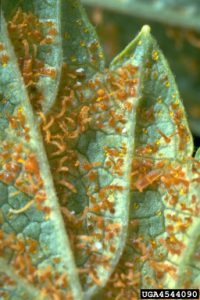
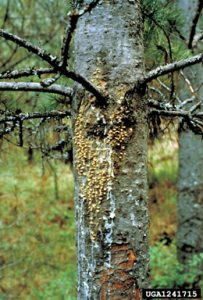
White pine blister rust has a complex life cycle that alternates between 5-needled (white) pines and Ribes species. There have also been reports of the disease using Pedicularis species (Louseworts) and Castilleja species (Paintbrushes) as alternative hosts instead of Ribes.
The disease cycle begins in late summer and early fall when an airborne spore infects the needles of a white pine tree. Yellow or orange spots begin to appear on the needles shortly after infection as the spores spread towards twigs and branches. After a year of infection, spindle-shaped orange swellings called cankers will appear on the branches. Over time, these bright orange canker sites turn dark, rough, and swollen. They interrupt water and nutrient flow towards the top of the tree, resulting in the death of higher branches. White blisters will develop on the cankers 2-5 years after initial infection but turn yellow in colour when they’re ready to rupture and release aeciospores. These aeciospores are carried in the wind to infect the leaves of nearby Ribes, which eventually produce basidiospores that are released in the fall to infect white pine.
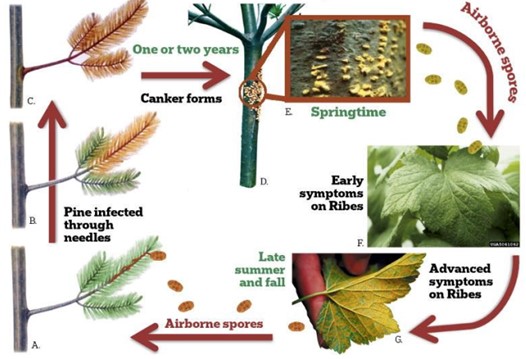
White pine blister rust spores thrive most in cooler, moist conditions during the late summer and early fall. These ideal conditions are usually present closer to the ground where there’s a higher moisture content. For this reason, lower branches and shorter, younger trees that stay wet longer are at a higher risk of infection.
*White pine blister rust can only survive in living tissue. It cannot be found in dead trees or dead plant material.
White Pine blister rust is native to Asia and was introduced into Europe before coming to North American. It is now found throughout the range of white pine in Ontario and throughout Canada: Eastern white pine can be found from Newfoundland to Manitoba; Western white pine can be found in British Columbia; limber pine and white-barked pine are found in British Columbia and Alberta.
To report a sighting or to check up-to-date distribution maps of recent reports, visit EDDMapS.
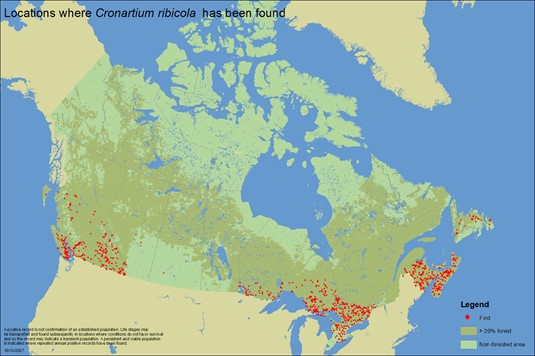
Ecological Impacts
White pine blister rust kills white pine trees of all ages and sizes. Younger trees typically die soon after infection as their smaller size makes it easier for the fungus to reach the trunk from the needles. This fungal pathogen can therefore limit regeneration, making it difficult for white pine trees to grow and establish themselves. White pines are of great ecological importance and the loss of these trees can negatively impact the wildlife that rely on them for food and shelter. For example, white pines are common nest sites for a variety of birds, such as bald eagles and great horned owls. Additionally, it can take many years for white pine blister rust to kill a larger tree. During this time, top-kill (canopy death) in larger pines can interfere with cone production and dispersal, limiting reproduction. This, in turn, can reduce the available resources for wildlife. For example, several songbirds and small mammals that consume eastern white pine seeds will need to search for alternative food sources when diseased tree produce less cones.
Economic & Social Impacts
White pines are a valuable source of softwood lumber as its wood is durable yet easy to work. They are used to make a variety of important products, including doors, cabinets, paneling, furniture, and moldings.
Dying and dead white pine trees that interrupt a green landscape are usually thought to be displeasing. These types of trees are generally unappealing to the public, resulting in less tourism and contentment.
White pines are also valued culturally, with reports of them being used for medicine by several Indigenous peoples in North America.
Management
Silvicultural practices and genetic approaches have both been used to manage white pine blister rust and protect high-valued white pine species. Common silvicultural practices include site selection, vegetation management, and pruning.
Site Selection – All white pines are susceptible to WPBR, but specific site conditions (such as aspect, slope, soil type and the presence of Ribes) can increase the risk of infection. It is best to plant new white pines in areas that are unlikely to promote WPBR infections. White pines planted on a mid to upper dry slope with an open canopy and few (if any) Ribes will be the safest. Alternatively, white pines planted on low, moist sites with dense underbrush, patchy canopy openings, and nearby Ribes are at a much higher risk of becoming infected with WPBR.
Vegetation Management – Removing dense local vegetation can be beneficial as it reduces the relative humidity and improves air circulation. These factors limit spore growth and success, which overall reduces the likelihood of WPBR infections. Reducing dense underbrush can also limit the competition between plants and young white pines for access to light and resources, which ultimately increases the trees growth and survival.
Pruning – Early pruning of highly susceptible lower branches can be effective in reducing infections on the main stem or trunk. Pruning can reduce the formation of lethal cankers that eventually girdle and kill the tree.
Genetic approaches that try to improve resistance in white pines seems promising, though resistance breeding programs have had limited success with eastern white pine in Ontario.
Chemical and biological controls have not been used for white pine blister rust as they have shown to be ineffective thus far.
References
https://wildadirondacks.org/trees-of-the-adirondacks-eastern-white-pine-pinus-strobus.html
https://www.exoticpests.gc.ca/es-details/disease/24
https://www.ontario.ca/page/white-pine-blister-rust
Thoma, D.P., Shanahan, E.K., Irvine, K.M. (2019). Climatic correlates of white pine blister rust infection in whitepark pine in the greater Yellowstone ecosystem. Forests, 10(8), 666. https://www.mdpi.com/1999-4907/10/8/666


